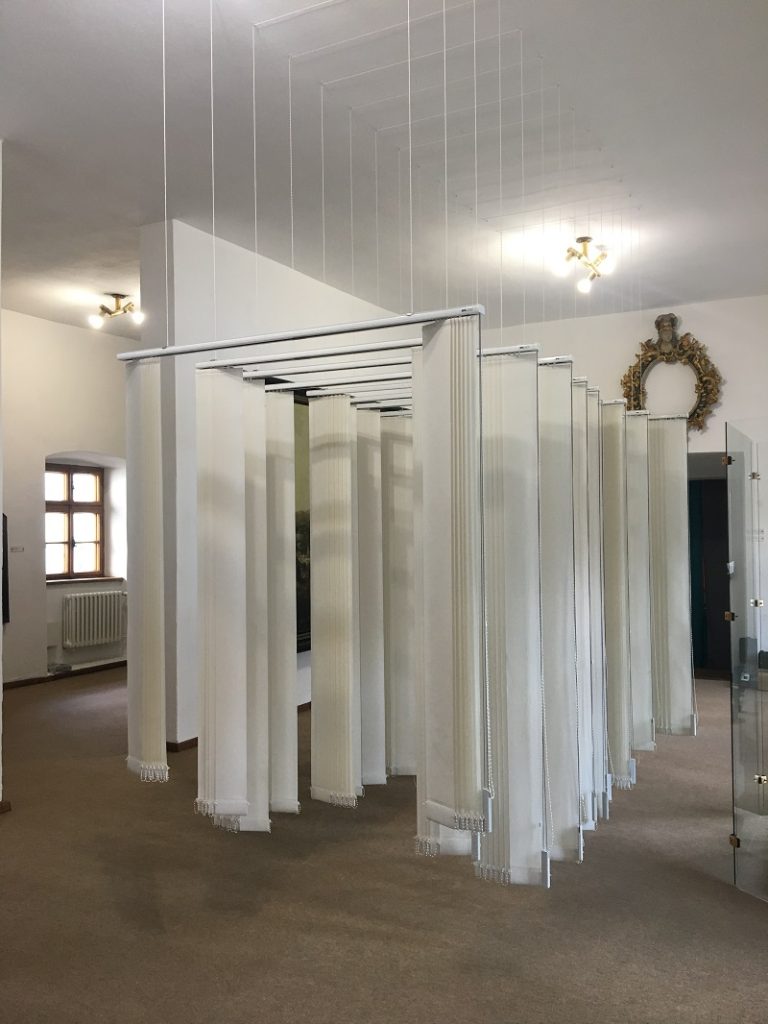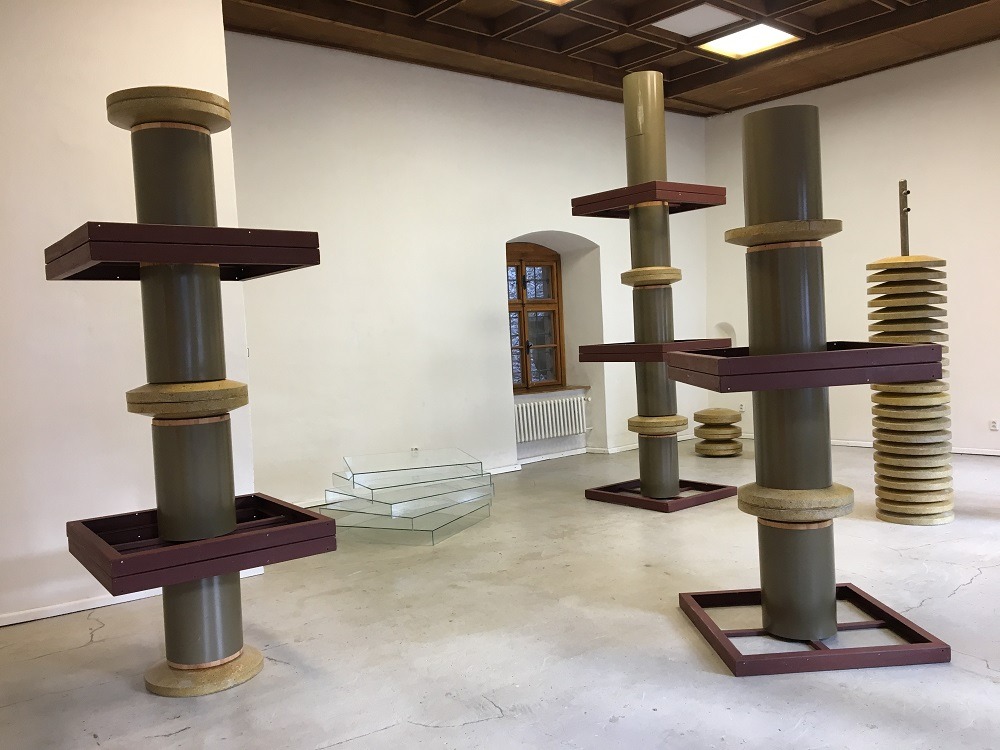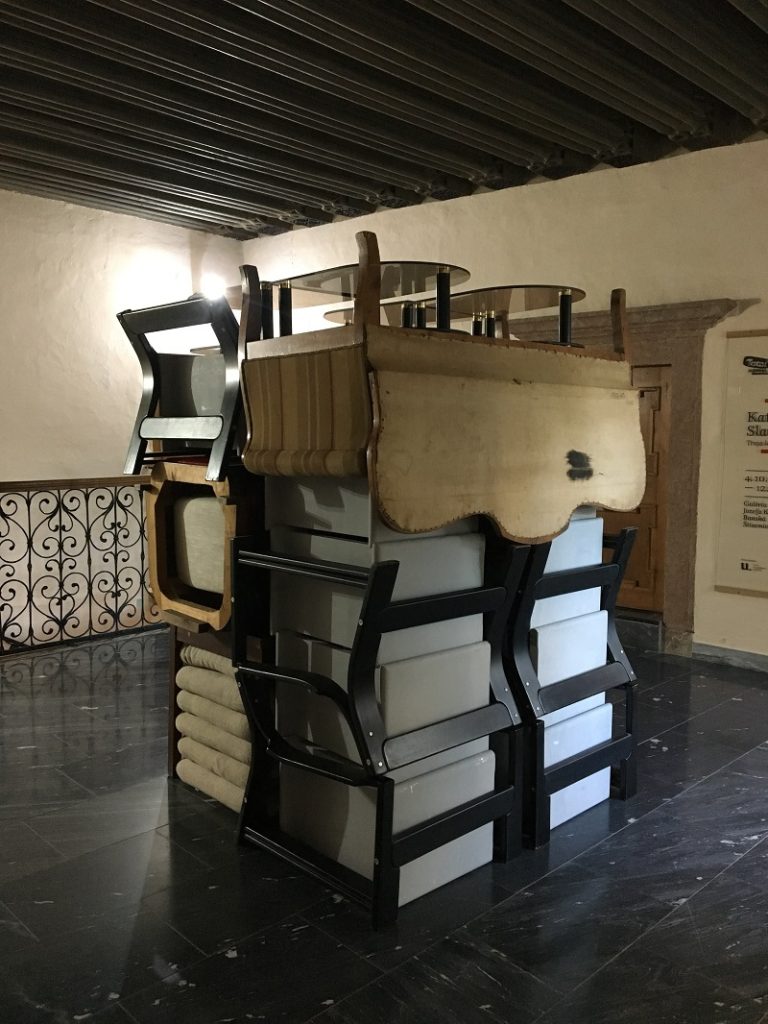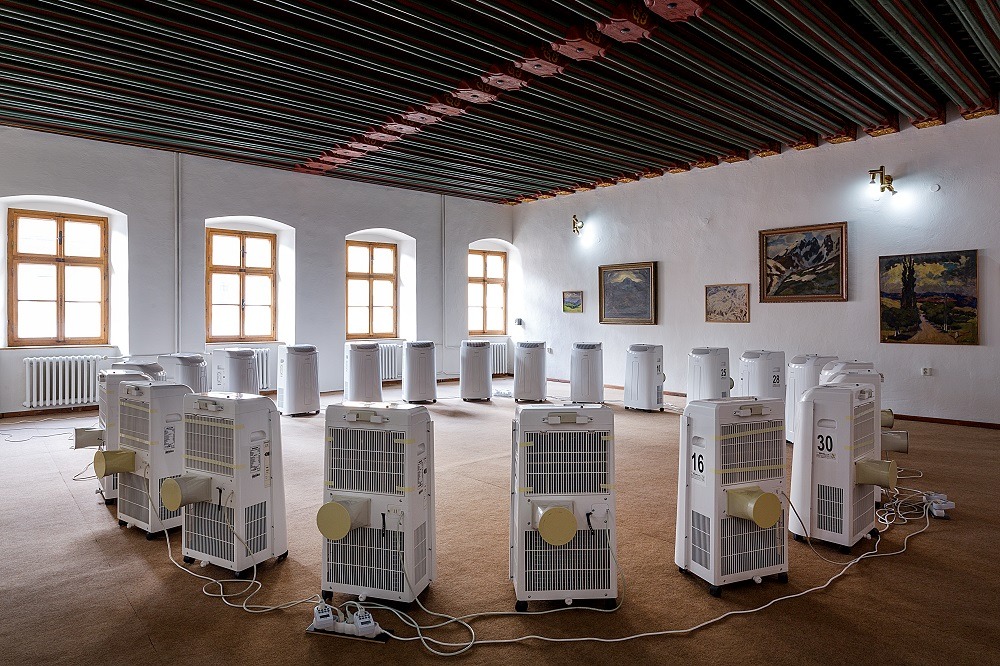The gallery as an exhibition
Banská Štiavnica (Selmecbánya) is the Capital of culture in Slovakia in 2019. One of the significant events of the program series organized because of this is the exhibition of artist Ilona Németh and curator Lucia Tkáčová titled Time solidifies at its core – Čas tuhne uprostred in the Jozef Kollár Gallery, which can be visited between 18th of October and 30th of November. The artist used objects found in the gallery for the five site-specific installations, while cleaning and re-thinking the exhibition spaces.
What was the apropos of the exhibition? Where did the request come from?
Banská Štiavnica is the Slovakian capital of culture this year. Lucia Tkáčová, who is an artist and a curator as well, moved to the nearby Vyhne after spending four years in Berlin, because it is part of her descent. She used to often visit Banská Štiavnica and fell in love with a gallery-building, the Jozef Kollár Gallery, which came to be from assembling three separate buildings, and was opened in ´89. She started thinking about how lovely it would be to make contemporary exhibitions here, which had never been done before. However the gallery was in no way suited to host contemporary exhibitions, so she started gradually working on creating the right circumstances, convinced the locals, the director of the mining museum and the directress of the gallery which as institution was part of the museum, about the importance of this initiative. Since the budget of the gallery functioning as a state institution could not cover such exhibitions, Lucia herself applied for funding in the frame of the Capital of culture project, and got the support from which she could make multiple exhibitions happen during the year. She also invited me.
This was not the first time you met Lucia, you already had a past together.
Of course, I’ve known her for 15-16 years. When I started working for the University of Fine Arts, she was my first assistant for six years. Unfortunately, our paths separated after this, because we had so many exhibitions on our own, that we couldn’t organize our time in a way that the students would have someone with them at all times. She was the assistant, with whom we could lead the studio in a completely equal partnership, thus this was the best era of the studio. For me undoubtedly. Despite her being 10-12 years younger than me, we could have a complete understanding and come to an agreement in a lot of things, we had very similar values, we worked well together. Otherwise she became my assistant without us knowing each other, she was suggested to me by a young artist. But the work relationship later became a friendship.

A blooming connection then.
We had never made an exhibition together before. We worked together when I was one of the curators of the Universal Hospitality exhibition in Prague, and I invited her, she was then in an artistic duo with Anetta Mona Chisa (for quite a long time). So this one in Banská Štiavnica was our first work together where we also physically worked together on something.
Besides you, Cséfalvay András also partook in this exhibition.
One of the site-specific installations was created from those dehumidifiers, which they bought with the funding from the Norway Grants, and there is 23 pieces of it in the gallery. They were never mounted in, because the gallery does not make it possible. But Lucia’s eyes struck on these absolutely meaningless objects, and her dream was for us to make something out of them. We asked András to compose a musical piece for these devices. But this unfortunately was met with obstacles, for only two appliances could be on power at the same time. We worked with timers that had a limit of one minute. András made several exciting blueprints in various visual systems, in star-shape for example, but to no effect, since in the end if the visitor comes in and stands in the middle of the circle, they practically feel two air-blowing vents, because only two of them could be turned on at the same time. Then we decided to create a chain reaction switch, which makes the wind go around in 11 minutes. So, the musical piece did not come to be, not to the fault of András, but because of technical limits.
The Slovakian title of the exhibition is Čas tuhne uprostred.
This title was chosen by Lucia. This means, that time came together to become something, and stayed in the middle. Time solidifies in the middle.

This is a metaphoric title.
I don’t like poetic titles. For me the title of this exhibition – much like the titles of the particular pieces: Site-specific installation for the Jozef Kollár Gallery. That is how I call it for myself. If I would’ve had to give it a title, it would’ve been connected to the gallery, something like The gallery as an exhibition. Anyways, I never made a more site-specific exhibition than this one. On one hand because of the location, on the other hand, because of the materials that we made the exhibition out of, since except for two elements basically everything else is either from or in the gallery. But not as if I would be collecting tiny pieces of trash from the corners, like Jiří Kovanda does, who goes into an otherwise clean gallery, and finds things that he really does make an exhibition out of. This is not that case. Here the goal was to really eliminate the unnecessary objects. I already thought of them as residuals left here from different eras. Like when you gather seds, layers, from different geological eras, and interpret them in a way. Because of the site-specific aspect we made big-sized installations, which I can generally not allow myself to do, for several reasons: one of them is the change of times. In the nineties I did not think about whether there’s a point to making big-sized installations. This is not even an ecological question, it’s more about how after a while big-sized installations seemed autotelic. I was happy not only because I could work together with Lucia, but because in the end I got to work on big-sized installations – without a bad conscience. Meaning I was not the one bringing additional materials here for a high cost, which I would have to later, also for a high cost, transfer and store in some storage, but the opposite: the gallery itself was the material, all those unnecessary objects ruining the gallery, and by their recycling big-sized installations are created, which one can freely stand behind. This is a very good feeling.
What was interesting for you in the space?
For me what’s interesting in it is that it’s here in Banská Štiavnica, which is a reviving town, with a huge historical tradition that is a Hungarian, Jewish, German and Slovakian tradition. There is a gallery in its center, on the Szentháromság square, that contains quite peculiar elements. Namely because it has three building, from different eras: even inside one building it contains gothic, renaissance and baroque elements. And three buildings are even opened together in the upper floor. There are pretty special spaces inside, for example a wonderful baroque dining room with white stuccos. Or these fantastic ceilings, the richly carved and painted girders made in the 16th century, which have an exceptionally interesting story. When they went out of fashion, they got walled-up because it was considered shameful for someone’s house to have a ceiling like this. I know this from the manager of the gallery. So the girders were covered up, and nobody even knew about it until the forefront of the center building fell down in ´79, for being in such a bad shape. Due to the damage the girderage got unraveled. That was the reason for the restoration to drag off until 1989, because the restoration of the girders took so much time. Many people say that this didn’t exactly happen in a professional manner, but in the end they were saved. There’s also two internal yards in the central space, one of them can be visited, the other cannot, and in one of them you can see the sgraffitos of the internal spaces of the building, the restoration of which also leaves much to be desired. But all in all it is rare to have a building for your exhibition that allows you to see so many eras at the same time.

What materials and objects were used for the installations?
For this gallery which was opened in ´89, the inner exhibition space was engineered by two designers, who worked in the army. The huge showcases, massive panels holding the pictures, built from heavy materials probably reflect their way of thinking, and are still there to this day along with the carpets bought in ´89 (which was a big hit at the time), and strip curtains covering everything, protecting the pictures from solar radiation. Not the mention the various furniture that appeared in the space. From the installation system itself there were these strange, enormously heavy wooden elements, suited to be used as a table or a chair, painted greyish blue. There was only one piece of furniture that had a historical value: the sofa of Ede Gwerk, a painter from Banská Štiavnica. About all the other furniture I discovered, after taking pictures of them and asking around, that they were just brought here by people who never took them away. Thus, there is a baroque collection, a gothic collection and the paintings of Jozef Kollár in the gallery, these are the permanent exhibitions. And in all the rooms apart from the set-up there was furniture thrown around. My first idea was to collect all the furniture, and compress an object out of them, in order to densify it as much as possible, and then to transfer it to a gallery in Bratislava to exhibit it as an art piece. Then after multiple visits I found put together in two different places the elements of the installation system, that were currently out of use. I thought these two should be combined. But in the last week before the exhibition I realized that they cannot be combined. There are such qualities in the installation system, that should be used by themselves, and not mixed together, because there is more in that than just to be set into such a cube. By then it was obvious that the string curtains would be exchanged by UV-filtered folias, and the installation materials would be left for us to use, along with the furniture and the extractor fans, this way we had four kinds of material, four conglomerates, from which we created 5 installations. Beside the materials, it was also very important to choose the spaces, there is for example a high space that was built in the eighties with a very interesting lacunar, that could sometimes be considered ugly, and sometimes beautiful, that’s where we put the pillars because that was where they fit.
Let’s talk a bit about the installations. When the visitors first enter the foyer of the gallery, they immediately meet…
A spiral pillar, consisting of the metal cases and the covers of the showcase tables from the installation system in the gallery. The covers were used to hide the raw iron. These frames did not get rusty until this day, despite being kept outside, so they were made out of super materials. It also came as a shock to us, that these materials are not at all light, I could not lift anything from these by myself. So the whole point of the installation is the changed gallery. This is not on my account, since Lucia has been working here for a year now, I arrived into luxurious circumstances, because the locals were prepared for the additional changes, just like all year before. Lucia was happy about my idea because it somehow finished all that she started from the beginning of the year. But we did not agree on this beforehand, I could have done anything I wanted.
So you freed the gallery of all the unnecessary weight and burdens.
Yes. When you enter the space, you see a bunch of unnecessary stuff, like the footboards containing various information in the foyer, which might have had its function in the gallery, but after a while it was only an eyesore. When the idea of making this spiral form out of iron was born, it turned out that if you put something in, all the other things become redundant. I could see on the fourth day of the installation that it’s not going to be good to have it there, but I thought I will let them know it should be put away on Friday. It was cathartic when I came in on the day of the opening and I saw that the employees of the gallery were carrying these boards away – on their own account! So the object standing here for all these years started bothering them as well. Thus, the exhibition rid the gallery of its warehouse nature. This is like when in a flat there has not been money for any change in a while. You could see the frugality. When being comfortable in the old habits makes your vision hazy, you do not see these things. Lucia says she has a disorder: she can sense things invisible to others. But anybody can see this in contemporary art. Anything can be a piece of art since Duchamp. When he was six years old, my younger son once asked me upon arriving to an exhibition, if the plug or the fire extinguisher is already part of the exhibition?

The first exhibition thus had a fantastic effect! Let’s see the others!
This installation that we made out of the string curtains, was put in the old art collection on the first floor: we hung the curtains behind each other from the ceiling in the middle of the room, creating an ethereal installation, forming a gate, which we did not originally planned to be like this. I think it could just easily stay here, because it looks very nice, and is not at all disturbing the space. We have the third installation on the same floor: from the installation materials made for the reconstructed space opened in ´89, namely the elements of the tables and showcases, from which we made big-sized pillars out of. Every pillar is different, since we were given quite a lot of variation possibilities. It was put together with huge superhuman work by four people using ladders. The biggest one is more than five meters high, there are two pillars one element shorter than this one, and another one that is another element shorter than these. Apart from these we built a statue out of the 25-kilogram cast stone dials, the flat, circle-shaped element, that together weighs 750 kilograms. Because this exerts pressure at a point with a diameter of 40 centimeters, we turned to a structural engineer, so the floor wouldn’t collapse underneath. We finished it after the expert opinion of three structural engineers. We managed to create the compressed furniture-installation on the second floor. And the fifth one is the installation made out of the dehumidifiers, which I already mentioned, and that was named Stonehenge by Lucia at the opening. So it should be emphasized, that all the while the space was rid of the unnecessary objects. For example the string curtains disappeared from the windows, thus opening a view to the Szentháromság square. We could say the UV-filters on the windows are the sixth installation, because the view is also an important spectacle. We gradually pealed everything off the exhibition halls, like the dusty atelier imitation of the gallery’s denominator, and we brought the furniture out from the halls of the permanent exhibitions. We also had to repaint after 30 years… the Kollár-collection also had to be rethought, since they put it together in ´89 based on a certain approach. This was the work of the gallery director Iveta Chovanová and Lucia, I didn’t participate in that. These pictures feature the four ancient elements: earth, water, fire, air, mostly air and wind. Fewer paintings remained, in a thematic compilation. Not to mention including the Gwerk-pictures, which were not exhibited before.
There are a lot more Kollár-pictures.
Yes, but the second floor is basically about the gallery’s denominator, that’s where the Kollár-collection can be found. The pictures of Ede Gwerk were removed because they were displayed under unworthy circumstances, and there is an intention of creating a proper Gwerk-collection.
The exhibition created here thus brought a radical change into the life of the building or the institution. And when it is over, because it is a temporary exhibition, then an ethereal, cleaner space will be left here, better serving the visitors.
It definitely follows or is more suited to the contemporary attitude towards museums and galleries. It is however still far from ideal, but the circumstances are much better already.
This means the time that seemed to have been standing can finally move forward.
For some absurd reason this gallery falls under the Ministry of the Environment, because it is part of the mining museum. This now became a venue that made it be part of the map of Slovakian contemporary galleries. This is the biggest accomplished of Lucia in this past year. She made exhibitions like Kristálylánc (Crystalchain), which is one the best exhibitions I’ve seen in my life. It was shocking, coming into a shriveled gallery, walking through a collection that’s been there for a hundred years, going down some stairs, and suddenly arriving into a space that opens up a whole different world. Already there is Banská Štiavnica, the Szentháromság square, you go inside this building, where time stands still, everything is covered with dust, and suddenly there is this fantastically densified and wonderfully arranged content. Lucia is a perfectionist (which I also am by the way), everything she creates is going to be perfect. Kristálylánc brought an exceptional quality. Lucia invited artist who create very exciting things in contemporary art. For example, they even opened the shaft under the building for a sound-installation, on which a Polish artist worked for weeks, with 18 women from Banská Štiavnica, holding a workshop. This means the things that have been happening here this last year are almost like a revolution.

Can the attention towards the gallery liven up on account of this? Previously the event organizers of Banská Štiavnica complained about how the festivals and cultural events are more visited by outsiders. Can it be, that this is going to be the year that makes contemporary art more interesting for the locals too?
There were surprisingly many people on the opening, and they were mostly locals, since Banská Štiavnica is too far for the people of Bratislava to come. I think it was a good idea to open the gallery of the amateurs as well. It is also fantastic that in a town this small 28 amateur artists applied for an open competition, and also that these exhibitions were made with the same precision and quality as ours, they got the proper space and lighting. The way you get the audience to acclimatize also matters. The people from the gallery told us that this many people don’t usually come to the openings.
Banská Štiavnica is the cultural capital of Slovakia this year. How did the town affect you, what inspiration did you get here?
Banská Štiavnica is a pretty strange place. Right now, the center of it seems a bit like a town from a fairy tale to me. But the locals live up in the residential estates, they were forced to move there. Thus it is a two-natured town: the ones who can value it go to the fairy tale town, like the tourists from various nations, who feel like the town is to some extent their own, there’s a coffee shop and restaurant system serving the tourists, that works in a strange manner, because there is nothing from Monday to Thursday, all of it comes alive from Thursday night until Sunday night, and the contrast is so big, that on a Saturday night you have to think twice about going for a coffee, because you might not fit inside. And it’s not only about the tourists, since a lot of people bought houses here, they restored these buildings, a lot of people from Bratislava live here on the weekends for example. Otherwise the town is beautiful, it is worth coming here, but it has more layers. It is obviously great that it got tidied up, thank God a lot of the original buildings remained. It also touched me, that back in the day the main square was formed by that you bought yourself a mine, and you built a house over it. Mind-blowing! I would compare it to Venice: there are special things here that cannot be found anywhere else. It’s also exciting that there is still gold here. This town is fantastically interesting, but in a way it has also fallen apart. One of the intentions of this cultural year was to get the people from the residential estates down to the center.
Time solidifies at its core – Čas tuhne uprostred
Banská Štiavnica, Jozef Kollár Gallery
18th October – 30th November 2019
Translated by Csilla Nagy Hajnal
Photographs: Ilona Németh and Lukáš Rohárik
Cover photo: József Rosta
Ha tetszik, amit csinálunk, kérünk, szállj be a finanszírozásunkba, akár csak havi pár euróval!
